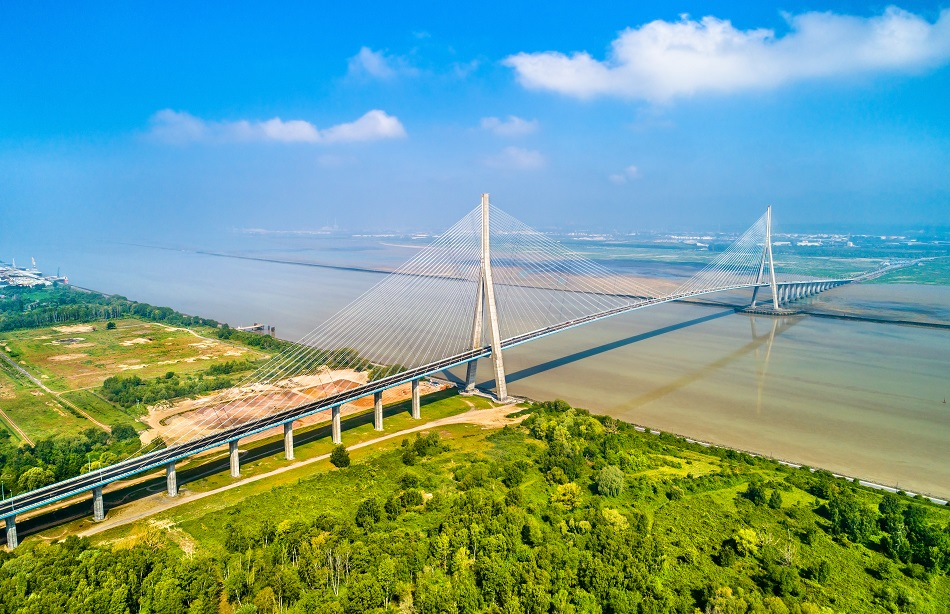
Image Credit: Leonid Andronov/Shutterstock.com
Le Pont De Normandie (English: Normandy Bridge) is a road bridge that is built across the river Seine. It connects the French cities of Le Havre and Honfleur. The owner of this bridge is the Chambre de commerce et d’industrie du Havre.
It was constructed between 1988 and 1995 and when it was built it was the longest bridge in the world. It also held the record for the longest distance between piers for any cable-stayed bridge at the time. The records for the longest distance between piers and overall length were lost, respectively, to the Tatara Bridge in Japan and the Rio-Antirrio bridge, which spans the Gulf of Corinth.
Primarily a motorway toll bridge, pedestrians and cyclists can cross the bridge via dedicated walking and cycling paths.
Designing the Pont de Normandie
This bridge was designed and built by nearly 1600 people over the space of 7 years including designers, engineers, and suppliers. It was designed by Michael Virlogeux and Igor Zizic. In total, the bridge cost $465 million to build.
The Structure of Pont de Normandie
The main reason for building a cable-stay bridge instead of a suspension bridge was for its improved stability in high wind at a competitive cost.
The Normandy Bridge has 184 cable stays to support the weight of the deck, which is 23.6 m wide in total and allows for four lanes of traffic and two pedestrian walkways. The two pylons holding the cables are 214 m in height and weigh 20,000 t.
On completion, the bridge was tested with a weight of Lorries equal to 16,000 t to assess its load limit and strength.
Construction of the Pont de Normandie
The Pont de Normandie is predominantly a steel bridge, which was considered a landmark design during its time. MT Hoejgaard handled all the steelwork including the fabrication and erection of the steel bridge deck and also the supply and installation of the cable stays.
The construction of the foundations was performed between 1990 and 1992 while the construction of access ramps was handled between August 1991 and August 1993. The pylon construction was completed in August 1993, and the assembly of the metal section of the bridge's main deck was completed the year after. Construction of the pre-stressed concrete deck section of the main bridge by cantilever construction was over by October 1993.
A portion of the deck cantilevering out from the pylons was built as a hollow box made of pre-stressed concrete; however, the rest of the deck was made of steel.
The pylons are made from pre-stressed concrete and are identical except that the north pylon is built in the river channel while the south pylon is built on the bank of the river. Hence extra care had to be taken to create a sturdy foundation.
The foundation consisted of 13 circular cofferdams with a diameter of 8.92 m and 12 connection cofferdams. All the cofferdams were raised to 16m above the riverbed. The cofferdams create a dry area for construction to take place.
The bridge is equipped with mageba modular joints which allow movement and rotation in all three axes. The modular joints were installed in 1995, and even after ten years, there was no sign of wear-and-tear.
The cables are split into eight groups consisting of 23 each thus making up a total of 184 cables. The range of the cables’ length is 95m at its shortest and 460 m at its longest. The cables are covered in a polyethylene sheath and coated with a petroleum-based wax, which fills the spaces between the wires and the sheath of the cable.
Interesting Facts of the Pont de Normandie
- The Pont de Normandie has helped ease traffic congestion on the existing suspension bridge (Pont de Tancarville) across the Seine.
- The Pont Du Normandie’s length is 2,143.21 m (7,032 ft) and the stretch between the piers is 856 m (2,808 ft).
- Each cable can be removed individually for maintenance.
- There is no charge for pedestrians and cyclists who want to cross the bridge.
- On completion, the Pont de Normandie beat the record held by the Skarnsundet Bridge (1740 ft), Norway set in 1991, and the Quingzhou Minjang Bridge (China) in 1996.
- The earth's curvature and the immense length of the bridge required that the distance between the pylons had to be 2 cm greater at the top than at the base.
Sources and Further Reading
This article was updated on 24th February, 2020.
Disclaimer: The views expressed here are those of the author expressed in their private capacity and do not necessarily represent the views of AZoM.com Limited T/A AZoNetwork the owner and operator of this website. This disclaimer forms part of the Terms and conditions of use of this website.